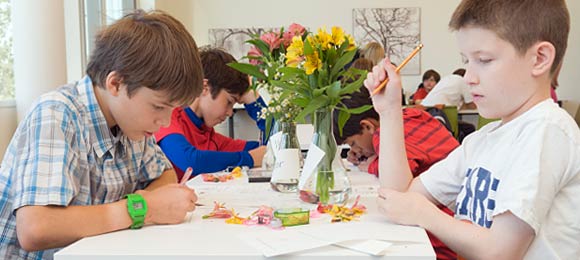
$120 per class
Monday through Friday, seasonally
10 – 11 a.m. or 11:30 a.m. – 12:30 p.m.
10 – 11:30 a.m. for 90-minute programs
A 1:7 ratio of chaperones to students is required.
Maximum number of students: 30
Pondering the Prairie (90 MinUTES)
Fall through 10/27
Students explore the Garden’s Dixon Prairie to learn about plant adaptations and ecosystem interactions. Their observations provide evidence to explain why these plants survive well in a prairie habitat and to argue that the structure of these plants supports survival, growth, and reproduction.
NGSS: LS1.A, LS1.C, LS3.B, LS4.C
Flower Lab
Fall, Early Spring
Why do plants make flowers? Students dissect flowers to examine their external structures. They gather evidence for how certain flower characteristics help attract pollinators so the plant can make seeds, and they use models to describe the life cycle of a flowering plant.
NGSS: LS1.A, LS1.B
New DIY Hydroponics (90 MinUTES)
Early Winter, Winter
Students work together to define a problem and design a solution: how to build a plant-growing system without soil. Students build, test, and discuss a hydroponic system using their choice of materials and strategies. Their systems can be used to plan and carry out investigations in the classroom or at home.
TREE Detectives (90 MinUTES)
Early Winter, Winter, Early Spring
Investigate how a tree’s external structures aid survival through four seasons. Students observe patterns in trees’ physical features and use their observations to create a dichotomous key to organize and identify trees scientifically.
NGSS: 4-LS1-1
Partners In Pollination
Spring
Discover the amazing connection between pollinators and flowers. Students examine pollinator behavior and the variety of strategies flowers use to attract pollinators. They observe examples of how certain flower characteristics appeal to particular pollinators, and they gather evidence to explain how a flower improves a plant’s probability of successful reproduction.
NGSS: LS1.A, LS1.B, LS4.C, LS4.D
Mighty Macros
Spring
Students examine creatures that live in the Garden’s lakes and use a model to understand how changes in the lake can affect the animals that live there. They learn how scientists count the number and variety of organisms they find in a lake to determine the water quality.
NGSS: LS1.B, LS2.A, LS4.D

